 |
| Tuna Auction, Tsukiji Market (築地市場, Tsukiji Shijō), 2005 |
Tokyo's Tsukiji Market (築地市場, Tsukiji Shijō) was well known for the tuna auction at its Inner Market before being closed and moved to Toyosu Market (豊洲市場, Toyosu Shijō) in 2018. Tsukiji Market actually consisted of two markets: the inner and outer. The Outer Market, still in operation, has many restaurants and retail shops selling fresh fish, produce, and all sorts of wares. The Inner Market, now closed, was the wholesale area for seafood, (including the famous tuna auction), produce, restaurants, and shops.
I first visited the Tsukiji tuna auction on 17 Feb 2005 when visitors had unfettered access to the Inner Market's outdoor-exposed tuna auction and seafood wholesale areas, could mingle with the the tuna buyers before, during, and after the auction on the auction floor, and then watch the tuna specialty vendors prepare the tuna for restaurants and other wholesale buyers. Unfortunately problems with tourists interfering with the auction, touching the fish, and generally disrupting business at Tsukiji Inner Market led to tuna auction and wholesale area visitor restrictions. This meant that tourists were banned from the tuna auction floor and made to apply for a limited number of time slots to stand in a restricted area to witness the auction. While still being allowed to watch the tuna auction in the restricted area, visitors could not enter nor walk the tuna auction floor. Today at the modern, totally enclosed, and temperature controlled Toyosu Market buildings, tourists are totally prohibited from the tuna auction and wholesale floors, so the experience and photographs in this article cannot be reproduced today. You now have to witness the Toyosu tuna auction from an enclosed second story gallery overlooking the auction floor and wholesale vendors after applying for a limited number of morning viewing windows online.
Please continue reading the rest of the article to see more photographs and to find out more about this never to be repeated experience on the Tsukiji tuna auction floor and Inner Market.
 |
| Zero-Emission Cart On Tsukiji Inner Market Road, 2005 |
Tsukiji Inner Market moved to Toyosu Market
The now closed Tsukiji Inner Market consisted of seafood, fruit, and vegetable wholesale areas, as well as the famous tuna auction. In 2005, all these areas were open to visitors to freely walk around and explore. As I mentioned earlier, the Tsukiji tuna auction and wholesale area access eventually became restricted, so the experience and photographs in this article cannot be reproduced or now at the auction's new home at Toyosu Market. The closed Tsukiji Inner Market was moved to Toyosu Market in 2018, where all the above mentioned areas do not allow visitors and can only be observed from second floor enclosed areas behind large glass windows. You can read about my 2018 visit to Toyosu Market, soon after it opened here:
 |
| Wholesale Seafood Market, Tsukiji Inner Market, 2005 |
Getting to Tsukiji Market at 5:30 AM
The Tsukiji tuna auction started early at 5:30 AM and completed by 6:30 AM. Before the Tsukiji tuna auction visitor restrictions, the only obstacle was getting to the market at that early hour and then once at Tsukiji, crossing the road to get to the Inner Market. Fortunately I was able to take the first subway from the station nearest my hotel in the morning and arrive at Tsukijishijo Station just a few minutes after the auction started. Some visitors had to stay at nearby hotels and then walk to the market, or take an expensive taxi to reach the market at that early hour. That is especially necessary today with the tuna auction now located at Toyosu Market since the first subway to the market arrives well after the auction starts.
 |
| Use Caution When Crossing the Road at Tsukiji Inner Market, 2005 |
Tsukiji Market is a short walk from Tsukijishijo Station, so I was able to arrive at the tuna auction soon after it started. I remember some of the passengers on the subway were workers at the market due to the distinctive white waterproof boots that they wore. Once tuna auction visitor restrictions were put into place at Tsukiji, visitors wanting to see the tuna auction were known to arrive at 3:00 AM to wait in line and apply for the limited viewing time slots for that morning, which was well before the first subway in the morning. You had to physically appear at Tsukiji's entrance gate early in the morning, well before the tuna auction started, to apply for one of the limited viewing times since there was no online option. The time slots filled quickly (i.e. there was a long line of people waiting, even at that hour) and if all the time slots were filled for that day, you were out of luck and had to try again the next morning. To see the auction at Toyosu Market today requires an online application for a chance to get a time slot to see the auction. The number of tuna auction viewing places is still restricted, but at least you do not have to physically show up at Toyosu Market early in the morning unless you have a confirmed time slot. The next trick is getting to Toyosu Market that early in the morning before the tuna auction starts since the first subway to the market does not arrive until well after the auction starts. The only options to arrive in time to see the Toyosu tuna auction are to stay at a nearby hotel or take an expensive taxi.
 |
| Handcarts Laden With Tuna Have the Right-Of-Way Both Outside and Inside Tsukiji Market, 2005 |
Getting to the Tsukiji Tuna Auction
After entering the gate to Tsukiji Market, the next obstacle to get to the tuna auction in the Inner Market was the road surrounding the Inner Market. The road was the main avenue that all the vendors' and buyers' vehicles used to transport the seafood, produce, and wares at the market, and to get to the multi-story parking garage. Not only were there normal cars and trucks, there were also specialized zero-emission carts that transported goods around the market. Like electric vehicles, the carts were silent and moved quickly. The carts also had the right-of-way, so pedestrians had to also yield to them. The carts were just the right size, so not only did the carts traverse the outside road around the market, but also inside the corridors of the Inner Market buildings where the vendors sold their wares. There were also large handcarts that were used to move tuna throughout the market. While the handcarts did not move as quickly as the zero-emission carts, the handcarts still had to be avoided. So the road had to be crossed, and you had to be vigilant of this eclectic mix of constant fast moving traffic in order to enter the Inner Market.
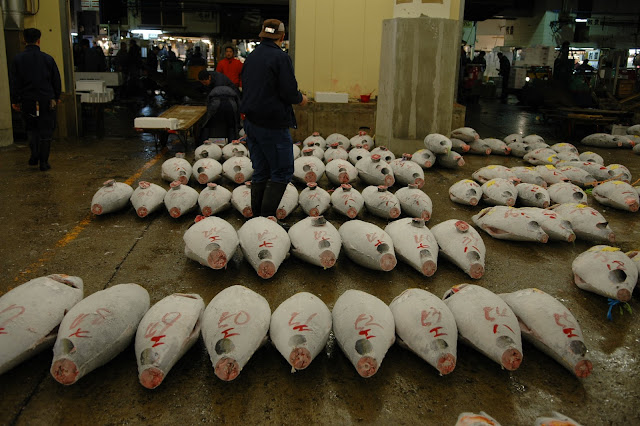 |
| Tuna Auction Floor Looking Outside Towards Tsukiji Inner Market, 2005 |
Entering the Tsukiji Tuna Auction Building
Once the Inner Market road was crossed, you had to walk through the Tsukiji Inner Market stalls to get to the outdoor-exposed building where the tuna auction was held. Once entering the tuna auction building, the impressive sight that greeted you was row after row of whole frozen tuna arrayed and sorted by size on the floor. The tuna was frozen to preserve freshness since the tuna was not only caught in waters near Japan, but also from the oceans around the world. There were small square pieces of colored paper on each of the whole frozen tuna to indicate the origin of the tuna. While the auction did not start until 5:30 AM, the workers at the market had been hard at work since early morning arranging the hundreds of frozen tuna to be sold that day on the auction floor.
Tuna Buyers
The tuna buyers would be the next group of people that you would notice once entering the tuna auction building. The buyers wore a baseball cap with their identification badge on the front, and carried flashlights, small fish hooks, and small notebooks. You would see many groups of buyers clustered around the tuna all across the auction floor, briefly examining a cut tuna tail, and then quickly moving on to the next frozen tuna. If you arrived early enough, you would also see a person with a brush and a bucket filled with red ink numbering each frozen tuna. As the buyers determined the quality of the tuna and which tuna to bid on, the auctioneer and buyers needed to know which tuna was being sold, and that was where the person with the red ink bucket numbering the tuna came in.
 |
| Buyer Examining Frozen Tuna Tail For Fat Content and Color, 2005 |
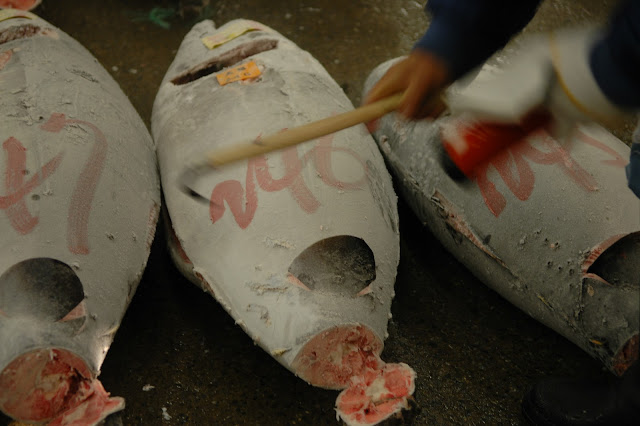 |
| Whole Frozen Tuna With Cut Tail, 2005 |
Tuna Buyers Assess Tuna Quality
The tuna buyers examined the cut tail of a whole frozen tuna to assess its quality, which determined how much they were willing to bid to buy the entire tuna. The buyers did not examine every tuna, but relied on their experience to determine which tuna to make their examination and ultimately which tuna to bid on. The buyer would use their fish hook and flashlight to look at the red color of the tuna tail, and use their fingers to feel a small piece of the tail to determine fat content. You would notice that many tuna have their cut tail pieces attached to the body using colorful polyester twine.
 |
| Auctioneer's Bell and Step Stool, 2005 |
Tuna Auction
There was not just one auction held for the tuna, but many auctions simultaneously. Another way to say this is that there were multiple tuna auction companies that sold tuna at the market. Selling tuna at the auction happened quickly, in less than 30 seconds per tuna, which accounted for all tuna at the auction being sold in less than an hour. Each auctioneer started the auction by standing on a step stool, ringing a handheld bell, and shouting loudly using a distinctive cadence to get the tuna buyers attention. As you stood on the tuna auction floor, you would hear the ringing of bells and the auctioneer's cadence all around you as tuna were auctioned in the market. The auctioneer was soliciting bids to sell the whole frozen tuna, and continually used the cadence, in what could almost be described as a song, until the tuna was sold for the highest bid.
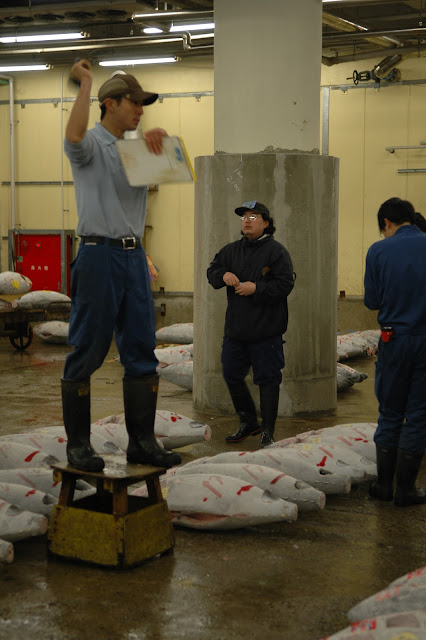 |
| Auctioneer Rings Handheld Bell To Start Tuna Auction, 2005 |
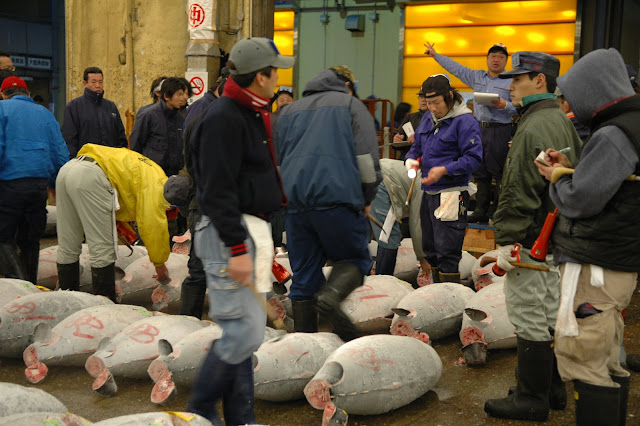 |
| Buyers Examine Tuna While Auctioneer Sells Tuna Using a Distinctive Cadence and Hand Gestures Indicating the Current Price, 2005 |
 |
| Tuna Buyers Use Hand Gestures To Indicate Their Bid, 2005 |
The auctioneer's cadence would be the only voice heard during the selling of tuna. The buyers did not use their voices to indicate their bids for the tuna, but signaled the auctioneer the price they were willing to pay using hand gestures. Each auctioneer used a distinctive cadence and the same hand gestures while auctioning the tuna to indicate the current bid for a given tuna. From a video that I watched on the auction, the cadence used by the auctioneer was not standard Japanese and was only comprehensible to those involved in the tuna auction. As the bid price changed, there would be short constant bursts of hand bidding gestures from the buyers coupled with the cadence and responding hand gestures from the auctioneer until the whole tuna was sold. After each tuna was sold, the auctioneer wrote down the red-numbered tuna sold, the winning buyer (hence the importance of the identification badge on the buyers cap), and the winning bid. When a frozen tuna was sold, another square colored piece of paper identifying the buyer was placed on the tuna. This allowed the workers that moved the tuna after the auction was over to collect and sort tuna according to the buyer.
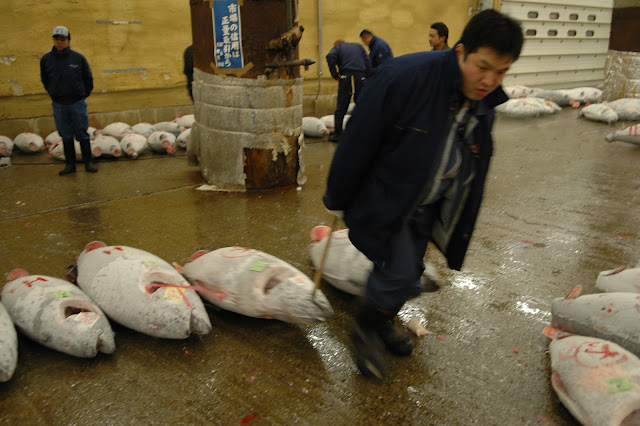 |
| Moving Sold Frozen Tuna By Hand, 2005 |
 |
| Loading Sold Frozen Tuna Onto Handcarts, 2005 |
 |
| Moving Sold Frozen Tuna By Forklift, 2005 |
Moving Sold Tuna After The Auction
After the tuna was sold, the next step was to move the frozen tuna from the market for delivery to the buyer. As you can imagine, the tuna buyers themselves did not take physical delivery of the tuna due to the enormous size and weight of the frozen tuna. The tuna delivery could be to a stall at the Inner Market or to a vehicle that would deliver the frozen tuna to the buyer's place of business external to Tsukiji Market. The workers that setup and arranged the tuna at the beginning of the auction, were now responsible for removing the tuna from the auction floor. As you can see from the above photographs, several means were employed to physically move the tuna. Moving frozen tuna by hand was hard work, with the tuna eventually being transported by handcarts and forklifts to their destination.
 |
| Removing Sold Frozen Tuna Heads, 2005 |
Cutting Tuna
Ever wonder how the tails and heads of the frozen tuna were cut, and what happened to them? As can be seen from the above photographs, a large electric rotary tuna saw with a long extension cord to make cuts is used. The tails were cut early in the morning before the auction started so that the buyers could examine each tuna for its fat content and quality. As you can imagine, cutting hundreds of tuna tails in the morning would be impossible without the use of power tools. Sometimes the tuna tail cut left the tail attached to the tuna body, but allowed the cut tail to swing away from the body for the flesh to be examined by the tuna buyers. Other times the cut tail was totally detached from the body, and a colorful polyester twine was used to attach and keep the tail with the body. In either case, after the tuna was sold, the cut tuna tail got delivered to the purchaser with the tuna body.
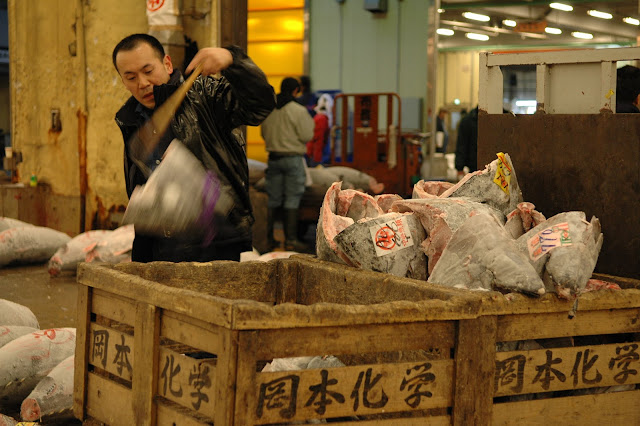 |
| Collecting Cut Frozen Tuna Heads, 2005 |
What is still a mystery to me is cutting off the heads of the frozen tuna. After the auction was done, the photographs above clearly show that electric rotary power saws were used remove the heads of some frozen tuna. Not all frozen tuna had their heads removed after being sold at the auction. In fact most buyers wanted the whole intact tuna delivered since the tuna head contains valuable and rare delicacies. The cut heads were collected, but it still is a mystery as to what happened to cut heads and who bought just the tuna bodies.
 |
| Collecting the Colorful Polyester Twine Used to Attach Tuna Parts After the Auction, 2005 |
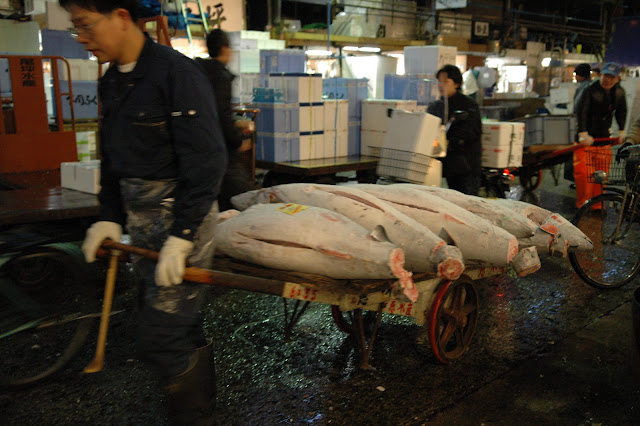 |
| Frozen Tuna Being Delivered to Tsukiji Inner Market, 2005 |
Tuna Vendors at Tsukiji Inner Market
Tsukiji Inner Market was the destination for many of the sold frozen tuna. Within the Inner Market, in addition to the multiple fresh seafood vendors, there were the tuna vendors responsible for breaking down whole frozen and thawed tuna into their wholesale parts for sale to restaurants and other customers. The tuna vendors used both traditional and power tools to disassemble the whole tuna. As I mentioned earlier, during my visit in 2005, Tsukiji Inner Market was open to all visitors, so it was possible to witness the tuna vendors preparing whole frozen and thawed tuna for wholesale. As time went on, Tsukiji Inner Market wholesale area visitor access became restricted and are prohibited at Toyosu Market. So today at Toyosu Market, it is impossible to watch the tuna vendors disassemble whole tuna.
 |
| Traditional and Power Tools Used to Disassemble Frozen Tuna Into Wholesale Parts, 2005 |
 |
| Cutting a Frozen Tuna In Half Using a Band Saw, 2005 |
 |
| Frozen Tuna Cut In Half, 2005 |
 |
| Frozen Tuna Half Cut Into Quarters Using a Band Saw, 2005 |
Preparing Thawed Tuna
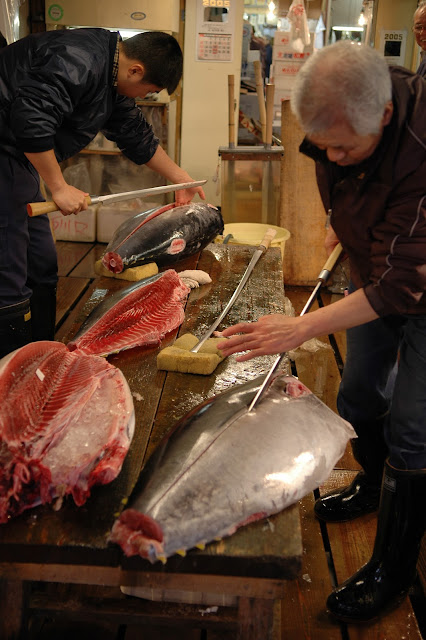 |
| Cutting Thawed Whole Tuna With the Traditional Maguro Bōchō, 2005 |
The maguro bōchō is a long knife with a blade length of 30 cm (12 inches) to 150 cm (60 inches), in addition to a long handle. The knife can fillet a tuna in a single cut, although two people usually are needed to handle the knife and the tuna. The flexible blade can be curved to match the shape of the spine to minimize the amount of meat remaining on the tuna carcass. [1]
 |
| Two People are Needed to Handle the Maguro Bōchō and Tuna, 2005 |
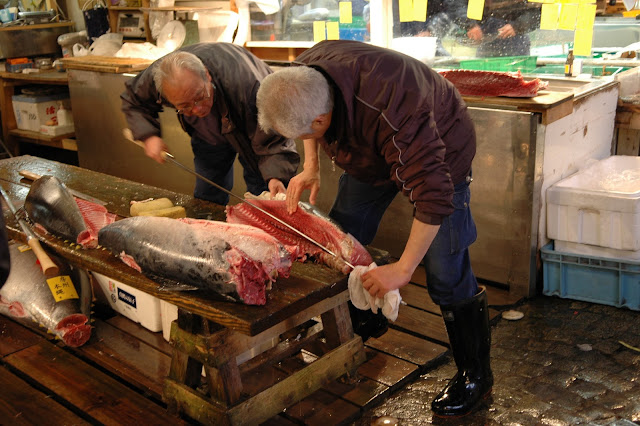 |
| Filleting the Tuna Using Maguro Bōchō Requires Two People, 2005 |
 |
| Cutting the Tuna Fillet Into Wholesale Parts, 2005 |
 |
| Trimming Tuna Fillet Wholesale Parts, 2005 |
Conclusion
The Tsukiji Inner Market was closed in 2018 and moved to Toyosu Market due to aging facilities, the needs of the 2020 Tokyo Olympics (held in 2021), and the desire to develop (with an as yet to be named plan) the valuable land which the Inner Market occupied. The buildings at Toyosu Market containing the tuna auction and wholesale vendors are modern, totally enclosed, temperature controlled, and infinitely more hygienic than the old outdoor-exposed Tsukiji Inner Market. However, all the modernization and improvements came at the expense of one of the most unique tourist experiences in Japan. While the tuna auction at Toyosu Market can still be seen in a limited time slot from an enclosed second story gallery behind glass, you cannot experience the tuna auction from the "floor" as I was fortunate to do at Tsukiji Market in 2005. It is now impossible to witness the tuna vendors prepare and cut whole tuna into wholesale parts for sale because the Toyosu seafood wholesale market, together with the fruit and vegetable markets, do not allow visitors.
If you visit Tokyo and have never seen the tuna auction or market, I would still make the effort to visit Toyosu Market to attend the auction after applying and obtaining an online reservation. The Toyosu tuna auction is a unique experience, but in my opinion, a far smaller experience than my never to be repeated 2005 Tsukiji tuna auction visit.
 |
| Final Product. Wholesale Tuna For Sale, 2005 |
Tsukiji Outer Market (築地場外市場, Tsukiji Jōgai Shijō)
The Tsukiji Inner Market and tuna auction is now located at Toyosu Market. While the Tsukiji Inner Market is closed and the buildings demolished, the Outer Market is still open, and filled with restaurants, shops, and vendors waiting for visitors.
Name:
- Tsukiji Outer Market
- 築地場外市場 (Tsukiji Jōgai Shijō)
Address:
- 4 Chome-16番2号 Tsukiji, Chuo City, Tokyo 104-0045, Japan
- 〒104-0045 東京都中央区築地4丁目16番2号
Phone:
- +81 3-3541-9444
Access:
- Plan your subway trip using Navitime, Japan Route Finder & Calculator:
- Website:
- Get the app for real time scheduling on your mobile phone when traveling in Japan.
- Android:
- Apple:
- Tsukiji Outer Market is accessible from Tsukijishijo Station on the Toei Oedo Subway Line after a 6 min (400m) walk from Exit A1.
- The cost of the subway trip is not covered by the Japan Rail (JR) Pass.
- Use an Electronic IC Cash Card (e.g. JR Suica, Passmo) to pay fare.
- Information is accurate as of the published date of this article and is subject to change.
Hours:
- The Outer Market open everyday:
- 08:00-14:00 (Mon-Sat)
- 10:00-14:00 (Sun)
- Information is accurate as of the published date of this article and is subject to change.
- Website:
- Get the app for real time scheduling on your mobile phone when traveling in Japan.
- Android:
- Apple:
- The cost of the subway trip is not covered by the Japan Rail (JR) Pass.
- Use an Electronic IC Cash Card (e.g. JR Suica, Passmo) to pay fare.
- 08:00-14:00 (Mon-Sat)
- 10:00-14:00 (Sun)
Websites:
- Navitime, Japan Route Finder & Calculator:
- Website:
- Get the app for real time scheduling on your mobile phone when traveling in Japan.
- Android:
- Apple:
- Tsukiji Outer Market:
Map:
- Website:
- Get the app for real time scheduling on your mobile phone when traveling in Japan.
- Android:
- Apple:
References
[1] Wikipedia. "Maguro bōchō". Last modified: 26 Jul 2022. https://en.wikipedia.org/wiki/Maguro_b%C5%8Dch%C5%8D.
Support
- I hope you're enjoying these posts. If you're enjoying them, please go to https://www.facebook.com/ducksoupeasytravel/ and give it a like on Facebook.
- Also if you've been following my food blog, please go to https://www.facebook.com/ducksoupeasy/ and give it a like too.
- Thanks for your continued support and comments.

No comments:
Post a Comment